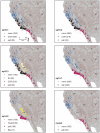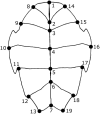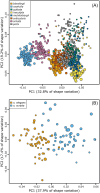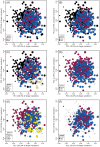Morphological Species Delimitation in The Western Pond Turtle (Actinemys): Can Machine Learning Methods Aid in Cryptic Species Identification?
- PMID: 38689939
- PMCID: PMC11058871
- DOI: 10.1093/iob/obae010
Morphological Species Delimitation in The Western Pond Turtle (Actinemys): Can Machine Learning Methods Aid in Cryptic Species Identification?
Abstract
As the discovery of cryptic species has increased in frequency, there has been an interest in whether geometric morphometric data can detect fine-scale patterns of variation that can be used to morphologically diagnose such species. We used a combination of geometric morphometric data and an ensemble of five supervised machine learning methods (MLMs) to investigate whether plastron shape can differentiate two putative cryptic turtle species, Actinemys marmorata and Actinemys pallida. Actinemys has been the focus of considerable research due to its biogeographic distribution and conservation status. Despite this work, reliable morphological diagnoses for its two species are still lacking. We validated our approach on two datasets, one consisting of eight morphologically disparate emydid species, the other consisting of two subspecies of Trachemys (T. scripta scripta, T. scripta elegans). The validation tests returned near-perfect classification rates, demonstrating that plastron shape is an effective means for distinguishing taxonomic groups of emydids via MLMs. In contrast, the same methods did not return high classification rates for a set of alternative phylogeographic and morphological binning schemes in Actinemys. All classification hypotheses performed poorly relative to the validation datasets and no single hypothesis was unequivocally supported for Actinemys. Two hypotheses had machine learning performance that was marginally better than our remaining hypotheses. In both cases, those hypotheses favored a two-species split between A. marmorata and A. pallida specimens, lending tentative morphological support to the hypothesis of two Actinemys species. However, the machine learning results also underscore that Actinemys as a whole has lower levels of plastral variation than other turtles within Emydidae, but the reason for this morphological conservatism is unclear.
© The Author(s) 2024. Published by Oxford University Press on behalf of the Society for Integrative and Comparative Biology.
Conflict of interest statement
The authors have not conflicts of interest to declare.
Figures





Similar articles
-
EMYDID HERPESVIRUS 1 INFECTIONS IN WESTERN POND TURTLES (ACTINEMYS MARMORATA) AND A RED-EARED SLIDER (TRACHEMYS SCRIPTA ELEGANS) WITH FATAL AND NONFATAL OUTCOMES.J Zoo Wildl Med. 2021 Dec;52(4):1275-1279. doi: 10.1638/2021-0044. J Zoo Wildl Med. 2021. PMID: 34998300
-
Bacterial communities of the threatened Western Pond Turtle may be impacted by land use.FEMS Microbiol Ecol. 2023 Nov 13;99(12):fiad143. doi: 10.1093/femsec/fiad143. FEMS Microbiol Ecol. 2023. PMID: 37950563
-
Reference Genome of the Northwestern Pond Turtle, Actinemys marmorata.J Hered. 2022 Nov 30;113(6):624-631. doi: 10.1093/jhered/esac021. J Hered. 2022. PMID: 35665811 Free PMC article.
-
Insights into Emydid Turtle Cytogenetics: The European Pond Turtle as a Model Species.Cytogenet Genome Res. 2019;157(3):166-171. doi: 10.1159/000495833. Epub 2019 Jan 11. Cytogenet Genome Res. 2019. PMID: 30630162 Review.
-
The ecology of overwintering among turtles: where turtles overwinter and its consequences.Biol Rev Camb Philos Soc. 2006 Aug;81(3):339-67. doi: 10.1017/S1464793106007032. Epub 2006 May 15. Biol Rev Camb Philos Soc. 2006. PMID: 16700968 Review.
Cited by
-
A review of migratory Alosidae marine ecology in the northwest Atlantic.J Fish Biol. 2025 Mar;106(3):677-695. doi: 10.1111/jfb.15977. Epub 2024 Nov 10. J Fish Biol. 2025. PMID: 39523025 Free PMC article. Review.
-
Artificial Intelligence in Aquatic Biodiversity Research: A PRISMA-Based Systematic Review.Biology (Basel). 2025 May 8;14(5):520. doi: 10.3390/biology14050520. Biology (Basel). 2025. PMID: 40427709 Free PMC article. Review.
References
-
- Amato ML, Brooks RJ, Fu J. 2008. A phylogeographic analysis of populations of the wood turtle (Glyptemys insculpta) throughout its range. Mol Ecol 17:570–81. - PubMed
-
- Angielczyk KD, Feldman CR. 2013. Are diminutive turtles miniaturized? The ontogeny of plastron shape in emydine turtles. Biol J Linn Soc 108:727–55.
-
- Angielczyk KD, Feldman CR, Miller GR. 2011. Adaptive evolution of plastron shape in emydine turtles. Evolution 65:377–94. - PubMed
-
- Angielczyk KD, Sheets HD. 2007. Investigation of simulated tectonic deformation in fossils using geometric morphometrics. Paleobiology 33:125–48.
-
- Arnqvist G, Mårtensson T. 1998. Measurement error in geometric morphometrics: empirical strategies to assess and reduce its impact on measures of shape. Acta Zool Acad Sci H 44:73–96.
Associated data
Grants and funding
LinkOut - more resources
Full Text Sources
Research Materials
